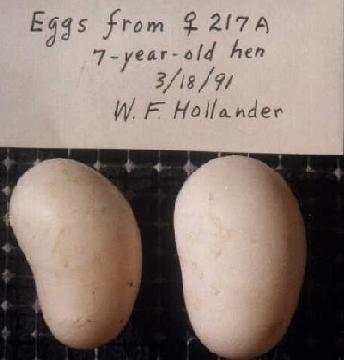American Pigeon Journal
October 1992, page 34.
All Pigeon Eggs Ain't 'Egg Shaped'!
by Robert J. Mangile
Eggs are not always typically 'egg shape' as we generally believe. But, we are seldom impressed with their variability unless their condition is extreme. For example: earlier this Spring (1991) I found a mostly normal looking egg, void of a shell. The yolk was visible through the soft, rather tough, membrane covering. Apparently, something went wrong and the egg failed to receive a coating of egg shell as do normal eggs.
Variations which occur more frequently don't seem to rivet our attention. Some have rough or softened shells or are quite large. Others may be rather long and tubular shaped or very small and round. Often the small ones lack a yolk and perhaps should not even be considered an 'egg'.
A Racing Homer hen (788-W)
of mine that regularly lays large eggs, laid an unusually large single-yolked
egg that measured approximately two inches long. Her sister (788-B)
also lays large eggs, which regularly measure approximately 1-3/4 inches
long. Both sibling hens lay larger eggs than
my French Mondain mongrels. The difference is quite striking when
compared to more typical Racing Homer eggs; which measures about 1-1/2
inches long or Ring-necked Dove eggs at a little under 1-1/4 inches long.
Such large, single-yolked eggs in the same family of birds suggests that hereditary plays a part in egg size. So..., when such things present themselves I try to make a small note of it in my breeding records, hoping it will solidify a new idea sometime in the future.
Someone might ask; "What good are all those seemingly useless notes in your breeding records?". That's a tough question to answer! However, one never knows when such notes or sketches become important; because memory is unreliable and hardly considered documentation to support a new ideas. What may seem to be a rare occurrence or condition may turn out to be less of a rarity if we all make and gather our notes. We might solve age old problems and/or learn many new things about pigeons from such little notes. The following just might be such an example.
In a letter from Dr. Willard
Hollander some time ago, he mentioned a female pigeon (217-A) that laid
a clutch of 'kidney shaped' eggs. Such a comment might seem inconsequential;
but..., if it jogs your memory, as this one did mine, and stir your
curiosity, they become the pertinent ones.
My recollections of a hen that regularly laid odd shaped eggs during 1990, spurred me to search my records. Eventually, I found the grade Chinese Owl hen (908-D) with my notes and a small sketch depicting eggs that were generally flat on one side. Not too different from a 'kidney shape'. Wow! Ain't that an unusual co-incidence? If I'd been more thorough I would have taken photos of them or cleaned them out and saved the shells for future reference. Documentation is vital.
Apparently, Doc wasn't able
to simple accept those unusual looking eggs without some inquiry.
First he took some photos (see, Figure 1.) to have a record of their appearance.
Then he autopsied the hen looking for a possible cause. Internally,
all
looked well, except for the possibility of some adhesions.
(Adhesions are the joining or sticking together of body parts that are
usually separate, which typically results from inflammation.) He
speculates that these adhesions may possibly hamper oviduct function and
alter the end result of the shell layering process. The idea that
adhesions may be the cause non symmetrical eggs seems plausible.
Figure l.
Shown are the 'kidney shaped' pigeon eggs laid by Hollander's seven year old hen (217-A). Both eggs were infertile.
Photo by Paul Hollander.
Have you seen any crooked eggs lately? I think I've seen another instance in my loft recently. I recall seeing an egg that looked ringed or squashed from end to end. But..., shame on me; because I've failed to make a note of it or take a photo of it. Something causes eggs to take on such unusual shapes. What can it be? Can anyone offer a better explanation for their production? Unfortunately, Hollander reported that the eggs in the photo were infertile. My records indicate that the flat sided eggs from my hen (908-D) hatched at the same rate as other normally shaped eggs. Can anyone add anything to this story?
# # #

